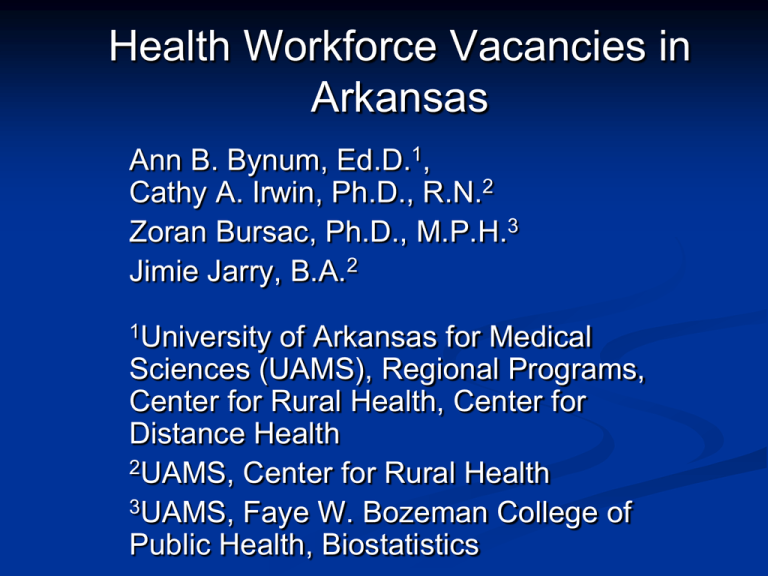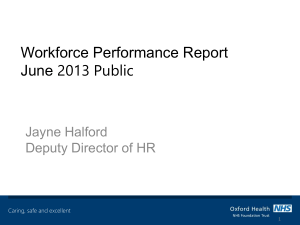Health Workforce Vacancies in Arkansas
advertisement

Health Workforce Vacancies in Arkansas Ann B. Bynum, Ed.D.1, Cathy A. Irwin, Ph.D., R.N.2 Zoran Bursac, Ph.D., M.P.H.3 Jimie Jarry, B.A.2 1University of Arkansas for Medical Sciences (UAMS), Regional Programs, Center for Rural Health, Center for Distance Health 2UAMS, Center for Rural Health 3UAMS, Faye W. Bozeman College of Public Health, Biostatistics Objectives 1. 2. 3. Explain the study purpose, research design/procedures, and instrument used in this study. Identify the current and expected workforce vacancies within the next 5 years for 90 health professionals in Arkansas by type of health care facility, regions in Arkansas and in Pulaski County. Describe the conclusions and implications for health professions education, clinical practice, and future research. Background Arkansas is facing a growing shortage of health care workers: Expected to worsen as the baby boomers retire Increased demand for health care services in Arkansas Growing total populations Increased elderly and ethnic minority populations Fewer uninsured patients as a result of health care reform initiatives Background Additional factors contributing to the shortage of health professions: Unfavorable work environments More satisfying alternative job opportunities Financial constraints with current recession Limitations in faculty, laboratory space, and clinical training sites for health education programs Background Geographic maldistribution of health professionals must be addressed for solving shortages of health professionals in Arkansas. Decline in the number of students choosing primary care careers Problems with recruitment and retention of primary care providers in rural areas Low compensation Rising malpractice premiums Professional isolation Limited time off Scarcity of jobs for spouses Impact of Workforce Shortages on Quality of Care Insufficient numbers and quality of health care professionals can affect the ability of health care facilities to meet the needs of their communities. National surveys of registered nurses (N = 657), physicians (N = 445), and hospital executives (N = 364) in 2004-2005 demonstrated that nursing shortages in hospitals had an impact on hospital capacity: Reduced available hospital beds (56%-78%) Delayed discharges (50%-69%) Increased wait time for surgery (45%-68%) Discontinued patient care programs (20%49%) Impact of Workforce Shortages on Patient Outcomes Results from a survey of U.S. hospitals from 11 states (N = 799) demonstrated strong relationships between nurse staffing variables and patient outcomes: Urinary tract infection Pneumonia Length of hospital stay Upper gastrointestinal bleeding Shock Failure to rescue (death rate related to hospital complications) Impact of Workforce Shortages on Health Status Shortages of health professionals can affect the health status Arkansas residents. In 2009, Arkansas ranked 40th in the nation for health status. Adequate numbers of health care professionals are needed to address the causes of preventable, premature deaths and to promote continued improvement in the health status of Arkansans. Purpose of the Study Assessed health workforce vacancies for 90 health professionals in Arkansas by type of health care facility, regions in Arkansas, and in Pulaski County Purpose of the Study The following categories of health professions were assessed for current employment vacancies during 2011 and expected employment vacancies within the next 5 years: Primary care physicians Physician specialists Nursing Allied health professions Pharmacists Dentists Facilities Surveyed Hospitals Nursing homes Medical clinics County health units Community health centers Area Health Education Center (AHEC) clinics Dentist offices Pharmacies Ambulance services Home health care services Regions of Arkansas Significance of the Study Results may be used to provide data for planning educational programs for health care in Arkansas. Planning for a supply of health professionals that will meet the demand Determine the needs of rural areas for health professionals Plan strategies in clinical practice and health professions education for solving workforce shortages in Arkansas Methods Cross-sectional survey design Measured current health workforce vacancies and expected vacancies within the next 5 years for 90 health professionals Other descriptive variables: Type of health care facility, regions in Arkansas, and Pulaski County Data collection during March-July, 2011 Study Population Total Population size = 4,212 Directors of the human resources department, administrators, and office managers Hospitals, n = 111 Nursing homes, n = 246 Medical clinics, n = 2,180 County health units, n = 102 Community Health Centers and dental clinics, n = 74 AHEC clinics, n = 8 Dentist offices, n = 865 Pharmacies, n = 395 Ambulance services, n = 62 Home health care services, n = 169 Procedures Completed survey instrument via paper (mailed survey) or on-line via a website Mailed reminder postcard after short time Mailed second questionnaire after sufficient response time Follow-up with nonrespondents via telephone: Reminded to complete the mailed or Web-based survey Telephone reminder followed the second mailed survey, 2.5 weeks after the mailing Three reminder calls were made to nonrespondents If the questionnaire was lost, address of web survey was emailed or a replacement questionnaire was emailed or faxed. Procedures Each survey instrument was assigned a code number to identify respondents with facility. Code numbers linked facility to zip codes. Zip codes were used to obtain the variable for region in Arkansas and county in which each facility was located. Zip code-based population statistics were used to determine the size of the community in which each facility was located. Web addresses and personal identification numbers (PINs) for population members to complete the on-line survey—Assured that each population member took the survey only once Instrument Vacancy survey instrument: Evaluated current and expected vacancies for 90 health professionals Eight survey instruments: Include health professionals that are employed in these types of health care facilities Hospitals Nursing homes Medical clinics AHEC clinics, Community Health Centers, and county health units Dentist offices Pharmacies Ambulance services Home health care services Instrument Vacancy survey was adapted from the 8-item vacancy survey developed by the Idaho Rural Health Education Center Survey was revised to include vacancies for 63 additional health professionals and expected vacancies within the next 5 years. Vacancy survey includes 3-11 items that assess current and expected vacancies for: primary care physicians (4 specialties); physician specialists (30 specialties); dentists; nursing (10 professions); allied health professions (42 professions); and pharmacy (4 professions). Participants responded to each item by listing the number of vacancies for each health professional. Data Analysis Data were entered and analyzed in the Statistical Package for the Social Sciences (SPSS), Version 15 and SASv9.2 Cross tabulations: Counted the number of vacancies for each health professional by type of health care facility, Arkansas regions, and in Pulaski County Frequencies of the data were evaluated for duplicate physicians’ vacancies in medical clinics and hospitals. Data Analysis Current and expected vacancies for health professions in the study population (N = 4,212 facilities) were extrapolated from the current and expected vacancies that were reported in the survey. Calculated by multiplying the number of current and expected vacancies for each health profession within each facility type by a constant multiplier to adjust for nonrespondents Each multiplier was specific to a facility type. Multiplier was a ratio of the total number of surveyed facilities for each facility type and the number of respondents for each facility type Data Analysis Determined health professionals that are currently under-produced and overproduced Calculated by subtracting the number of current vacancies for health professions in the study population from the number of graduates in 2010-2011 Sample of Respondents for Facilities Facility Type Sample Size Hospitals 68 Nursing homes 90 Medical clinics 568 County health units 102 Community Health Centers, 58 dental clinics AHEC clinics 8 Dentist offices 389 Pharmacies 181 Ambulance services 35 Home health care services 40 Total Sample 1,539 Response Rate 61.26% 36.59% 26.06% 100.00% 78.38% 100.00% 44.97% 45.82% 56.45% 23.67% 36.54% Results: Current and Expected Vacancies for Health Professions Extrapolated vacancies: Total of 7,021 current and 23,893 expected vacancies for nursing, allied health, and pharmacy professions; and for primary care physicians and dentists Physician specialists had 317 current and 456 expected vacancies. Allied health professions had the highest number of current (4,335) and expected (16,468) vacancies. Current and Expected Vacancies for Nursing Professions Nursing had 1,970 current vacancies and 5,675 expected vacancies. Current and Expected Vacancies for Nursing Professions 2500 Current 5 Year 2000 1500 1000 500 0 LPN ADN Diploma BSN APN Licensed Practical Nurse A ss ociate Diploma Nurse Bachelor of Science in Nursing A dv anced Practical Nurse Current Nursing Vacancies by Facility Type 800 715 700 622 600 500 400 283 300 243 200 100 9 17 40 37 0 AHEC Community Health County Health Clinic Home Health Medical Clinic Medical Hospital Nursing Home Psych Hospital 5 Rehab Hospital Expected Vacancies for Nursing by Facility Type 2000 1817 1800 1640 1600 1400 1200 948 1000 800 672 600 400 200 259 18 213 85 23 0 AHEC Community Health County Health Clinic Home Health Medical Clinic Medical Hospital Nursing Home Psych Hospital Rehab Hospital Current Vacancies for Nursing by Region 440 450 400 319 350 302 300 250 194 200 216 207 157 150 100 80 55 50 0 Delta Little Rock North Central Northeast Northw est South Arkansas South Central Southw est West Expected Vacancies for Nursing by Region 1662 1800 1600 1400 1200 1000 800 566 600 400 200 906 783 689 568 196 187 117 0 Delta Little Rock North Northeast Northwest South Central Arkansas South Southwest Central West Current and Expected Vacancies for Allied Health Professions Allied health professions had a total of 4,335 current and 16,468 expected vacancies. Socal Worker Current Physical Therapist Occupational Therapist Licensed Physical Therapy Assistant Environmental Services Dietary Aide Dental Assistant Current and Expected Vacancies for Allied Health Professions 900 800 5 Year 700 600 500 400 300 200 100 0 0 Phlebotomist Cert. Occupational Ther. Assistant Current EMT EMP Paramedic Dental Hygienist Cert. Mdical Assistant Audiology and Speech Pathology Current and Expected Vacancies for Allied Health Professions 400 350 5 Year 300 250 200 150 100 50 0 Surgical Tech Registered Respiratory Tech Current Radiologic Tech Psychiatric Aide Physician Assistant Medical Technologist Opthalmic Technologist Mdical Records Tech Medical Laboratory Tech Licensed Counselor Health information Systems Tech Activities Aide Current and Expected Vacancies for Allied Health Professions 300 250 5 Year 200 150 100 50 Current and Expected Vacancies for Allied Health Professions 5660 6000 5000 4000 3000 2000 1751 1429 339 1000 0 Cert. Nurse Assistant Home Health Aide Current 5 Year Current and Expected Vacancies for Allied Health Professions 60 56 50 40 40 32 30 27 20 10 9 0 Diagn. Med. Sonographer 5 Nuclear Med. Tech. 12 9 3 Biomed. Instrument Tech. 8 0 2 Cytotechnologist EMT Intermediate Health Educator Current 5 Year Current and Expected Vacancies for Allied Health Professions 80 68 70 60 50 46 40 30 20 10 0 Psychologist, Doctoral Prep. 76 72 43 45 38 28 6 3 Psychologist, Master's Prep. Radiation Therapist Cert. Respiratory Therapist Registered Dietitian Current 5 Year Current Vacancies for Allied Health Professions by Facility Type 1600 1463 1400 1200 959 1000 786 800 629 600 400 200 0 1 AHEC 135 234 91 23 Ambulance Community Health Dental Office Home Health Medical Clinic Medical Hospital 14 Nursing Psychiatric Rehab Home Hospital Hospital Expected Vacancies for Allied Health Professions by Facility Type 5000 4044 4000 4137 3791 3000 2601 2000 1009 1000 0 14 AHEC 376 Ambulance 86 Community Health 411 2 County Health Clinic Dental Office Home Health Medical Clinic Medical Hospital Nursing Home Psychiatric Hospital 44 Rehab Hospital Current Vacancies for Allied Health Professions by Region 900 800 700 600 500 400 300 243 200 100 0 Delta 878 792 676 564 454 419 166 Little Rock North Central Northeast Northwest South Arkansas 143 South Central Southwest West Expected Vacancies for Allied Health Professions by Region 4419 4500 4000 3672 3500 3000 2466 2500 1956 2000 1500 1000 500 1548 1398 456 277 278 0 Delta Little Rock North Central Northeast Northw est South Arkansas South Central Southw est West Current and Expected Vacancies for Primary Care Physicians Primary care physicians had a total of 514 current and 860 expected vacancies. Current and Expected Vacancies for Primary Care Physicians 500 Current 5 Year 450 400 350 300 250 200 150 100 50 0 Family Practice Inte rnal Medicine Pediatrics OBGYN Current Vacancies for Primary Care Physicians by Facility Type 328 350 300 250 200 158 150 100 50 2 20 5 0 AHEC Community Health Medical Clinic Medical Hospital Nursing Home Expected Vacancies for Primary Care Physicians by Facility Type 600 537 500 400 300 223 200 100 8 62 30 0 AHEC Community Health Medical Clinic Medical Hospital Nursing Home Current Vacancies for Primary Care Physicians by Region 120 110 94 100 79 80 61 60 40 41 46 39 29 16 20 0 Delta Little Rock North Central Northeast Northw est South Arkansas South Central Southw est West Expected Vacancies for Primary Care Physicians by Region 144 160 148 137 140 120 101 100 80 60 48 100 65 61 57 40 20 0 Delta Little Rock North Central Northeast Northw est South Arkansas South Central Southw est West Current and Expected Vacancies for Physician Specialists Physician specialists had a total of 317 current and 456 expected vacancies. 0 Nuclear Med Current Neurosurgery Neurology Nephrology Neonatology Intensivist Hospitalist Geriatrics Gastroenterology Endocrinology Emergency Med Dermatology Cardiology Anesthesiology Allergist Current and Expected Vacancies for Physician Specialists 50 45 5 Year 40 35 30 25 20 15 10 5 Other Current Urology Thoracic Surgery Surgery Rheumatology Radiology Diag Pulmonary Psychiatry Physical Med Pathology Pain Med Otolaryngology Orthopedic Surgery Ophthalmology Oncology Current and Expected Vacancies for Physician Specialists 50 45 5 Year 40 35 30 25 20 15 10 5 0 Vacancies for Physician Specialists by Facility Type Current Vacancies Medical Clinic, 142 Medical Hospital, 170 Psych. Hospital, 3 Rehab. Hospital, 2 Expected Vacancies Medical Clinic, 199 Medical Hospital, 253 Psych. Hospital, 5 Rehab. Hospital, 2 Vacancies for Physician Specialists by Region Current Vacancies Delta 15 Little Rock 43 North Central 37 Northeast 58 Northwest 50 South Arkansas 4 South Central 64 Southwest 2 West 44 Expected Vacancies 20 57 92 85 51 4 83 8 59 Current and Expected Vacancies for Dentists The total number of current vacancies for dentists = 131. The total number of expected vacancies for dentists = 372 Current and Expected Vacancies for Dentists 400 Current 350 300 250 200 150 100 50 0 Dentists 5 Year Vacancies for Dentists by Facility Type Current Vacancies Community Health Clinic, 32 Dental Office, 99 Expected Vacancies Community Health Clinic, 48 Dental Office, 324 Vacancies for Dentists by Region Current Vacancies Delta 19 Little Rock 18 North Central 8 Northeast 13 Northwest 26 South AR South Central 11 Southwest 4 West 32 Expected Vacancies 40 46 19 47 78 11 24 18 90 Current and Expected Vacancies for Pharmacists The total number of current vacancies for pharmacists = 71. The total number of expected vacancies for pharmacists = 518 Current and Expected Vacancies for Pharmacists 450 Current 5 Year 400 350 300 250 200 150 100 50 0 Certified Pharm Tech PharmD Vacancies for Pharmacists by Facility Type Current Vacancies AHEC Clinic Community Health 1 Medical Clinic 4 Medical Hospital 13 Pharmacy 51 Psych Hosp. Rehab Hosp. 2 Expected Vac 2 6 23 135 342 6 5 Vacancies for Pharmacists by Region Current Vacancies Delta 6 Little Rock 8 North Central 10 Northeast 11 Northwest South AR 4 South Central 13 Southwest 2 West 17 Expected Vacancies 13 28 52 89 54 25 80 43 135 Results: Arkansas Selected Healthcare Workforce Needs Under-Production of Health Professionals: Family Practice -235 Physical Therapist -227 Occupational Therapist -225 Dental Assistant -129 Advanced Practice Nurse -120 Internal Medicine -85 Certified Medical Assistant -85 Certified Nurse Assistant -85 Dietary Aide -70 Licensed Physical Therapy Assistant -69 Physician Assistant -38 Pediatrics -67 Results: Arkansas Selected Healthcare Workforce Needs Under-Production of Health Professionals: Certified Occupational Therapy Assist. -52 EMT – 41 Psychologist, Doctoral Prepared -35 Physical Med./Rehab -34 Obstetrics/Gynecology -34 Psychiatry -30 Neurology -19 Orthopedic Surgery -17 Medical Lab Tech. -16 Urology -15 Neurosurgery -7 Conclusions There were a total of 7,021 current vacancies for nursing, allied health, and pharmacy professions; and for primary care physicians and dentists. There were a total of 23,893 expected vacancies for nursing, allied health, and pharmacy professions; and for primary care physicians and dentists. Allied health professions had the highest number of current vacancies (4,335) and expected vacancies (16,468). Nursing had 1,970 current vacancies and 5,675 expected vacancies. Conclusions Primary care physicians had a total of 514 current and 860 expected vacancies. Family Practice physicians had the highest number of current (282) and expected (473) vacancies. There were a total of 317 current vacancies for physician specialists and Psychiatry had the highest number of current vacancies (42). Physician specialists had 456 expected vacancies and Hospitalists had the highest number of expected vacancies (47). Recommendations Patient-Centered Medical Home (PCMH) provides strategies for addressing the shortages of health professions in Arkansas. Involves health professionals working in care teams to improve efficiency in the delivery of health care and patients’ access to care Rural setting clinical training—Increased training for disadvantaged students and improved perception of rural practice Increased recruitment and retention of health professionals in rural areas Telemedicine, school telehealth programs, and the use of Advanced Practice Nurses Increased wages, job flexibility; improved job satisfaction, and mentorship programs Recommendations Apprenticeships, early and sustained education in health careers, flexible pathways to facilitate career development Financial support, academic enrichment, tutorials for admissions preparations, and motivational programs Recruit new faculty to replace the aging faculty Improved physical facilities and clinical placements for health professions education Improved salaries for health professions faculty Partnering with private entities, federal agencies, health professional training programs, and hospitals to share facilities and provide funding for student loans and scholarships Implications for Future Research Decrease nonrespondents Yearly assessment of current, expected vacancies for health professions Assess impact of health workforce shortages in AR on quality of healthcare, patient outcomes Examine job satisfaction






